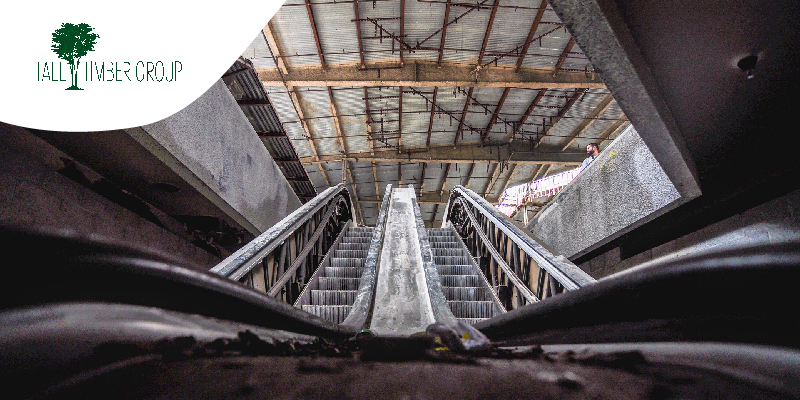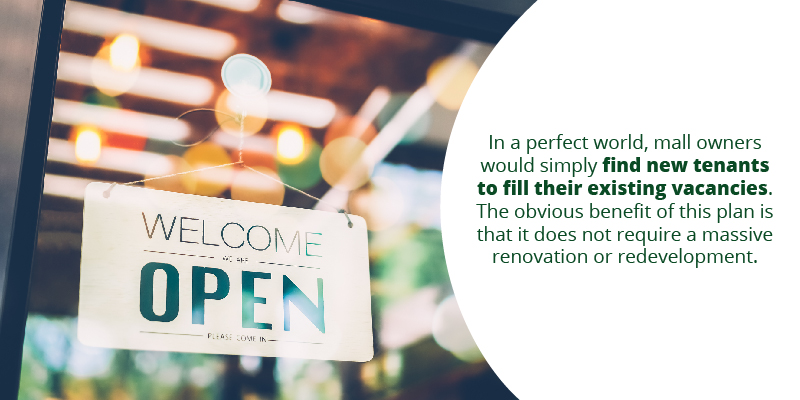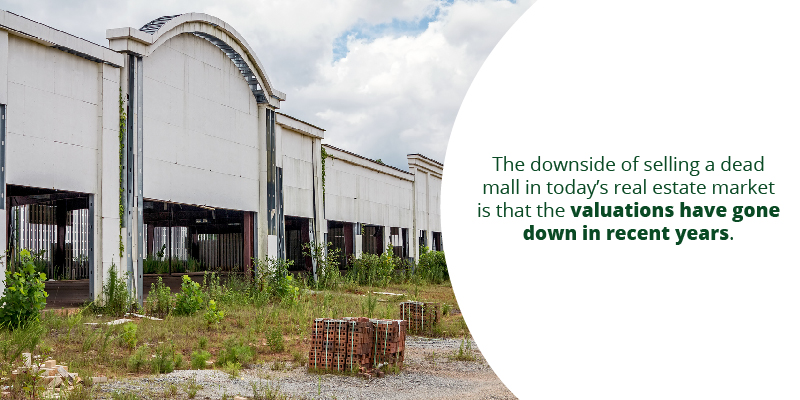
It wasn’t long ago that the traditional American mall was the staple of retail commerce. In 2020, it can feel like you are equally likely to find a mall completely abandoned than thriving with shoppers. In reality, recent estimates project that almost one in four malls will close or have closed all within a five five year period. Yikes. Commercial real estate investors have been taking huge losses in the brick and mortar space in recent years. Yet some investors have viewed losses like mall closures as opportunities to transform these spaces into revenue generating properties.
With this in mind, what can be done about the epidemic of American mall closures?
Option 1: Find New Tenants for Mall Spaces

In a perfect world, mall owners would simply find new tenants to fill their existing vacancies. The obvious benefit of this plan is that it does not require a massive renovation or redevelopment. Redeveloping a space as large as a mall would take years and incredible investment dollars to complete. Repopulating existing spaces with new renters is certainly a simpler undertaking. Despite all of the upsides, the question then becomes: is this a reasonable expectation?
One of the key factors that led to the downfall of the American mall was the rise of e-commerce. E-commerce giants like Amazon and eBay have syphoned sales away from brick and mortar retailers since their inception in the 90’s. The problem with finding new tenants for existing mall spaces is that most spaces were designed for flagship renters including department stores, clothing stores, and other struggling industries.
Option 2: Double Down on Amenities
The American mall infrastructure is dated, and it shows. It isn’t just the concept of shopping in an indoor mall that is old, it is also the gargantuan redundant architecture. Some malls have doubled down on the retail mall concept by renovating their facilities with modern amenities. Of course, this is an additional financial risk being put towards an already-dying industry. Yet many success stories are floating around about dead malls being brought back to life.
A key here is understanding the mall’s location, key demographics, and potential for growth. An example of a subset of malls who continue to thrive are upscale, “luxury” malls which cater to the upper class. The Bal Harbour Shops in Miami rent spaces to some of the most famous and expensive designer outlets in the world. This works for the Miami strip, but it of course will not translate across most of America.
Option 3: Repurpose Dead Malls
Many dead malls have found a new purpose after slight modifications turned their defunct spaces into fitness centers, medical clinics, places of worship, and even educational facilities. Despite the death of brick and mortar businesses being largely exaggerated, there are still plenty of industries starving for large, accessible spaces. Ample square footage is still desirable for gyms and churches, and these types of demand are not as volatile to market changes when compared to department stores and retailers.
As with our previous option, repurposing dead malls often includes renovation and/or redevelopment that could eat up a chunk of time and money. Mall ownership groups are often diverse and heterogeneous. Deciding to embark on such a dramatic shift in strategy is often what stalls these types of projects.
Option 4: Sell the Mall and Associated Properties to Developers

At some point, all investors and/or owners of struggling commercial real estate properties have to make a decision to fish or cut bait. Many mall owners are doing just that and selling these massive properties. Of course in order to sell you must first find a buyer. The benefit of selling to a new group is that modern commercial real estate investors may be better equipped to face the challenges of finding new tenants, improving amenities, or repurposing existing infrastructure to make a dead mall profitable again.
The downside of selling a dead mall in today’s real estate market is that the valuations have gone down in recent years. Where some dead malls have shown signs of life through creative problem solving, the majority of malls continue to struggle, dead or not. The business of major retailers has changed since the invention of the internet and it will likely never fully recover. The decision facing mall owners and managers now is which of these (and other) options will offer the best return on investment in a bleak marketplace.
Going Forward
Malls aren’t what they used to be. It is very unlikely they ever will return to their glory days as the hub of modern commerce. Instead, these massive structures have been repurposed, renovated, and updated to bring their aging architecture into the modern era. Thriving malls have one major concept in common: they are being proactive rather than reactive in their approach. The “do-nothing” method simply is not an option for today’s dying malls. While the four options presented above are certainly not the only options on the table, they lay out the basic concepts of how current malls can retain their relevance for years to come.

